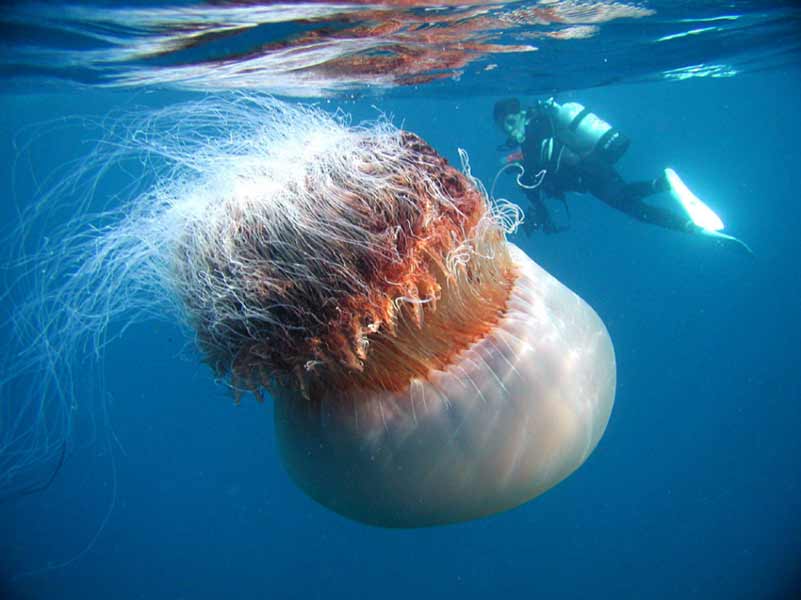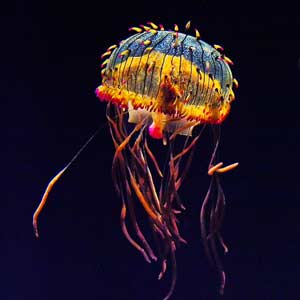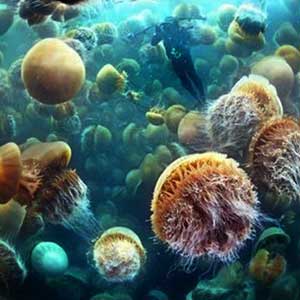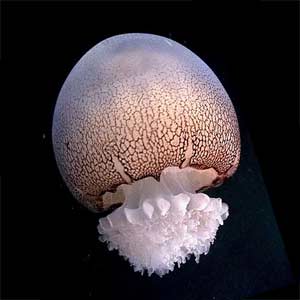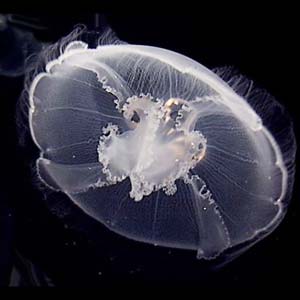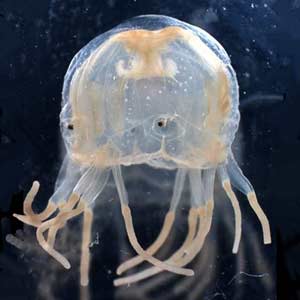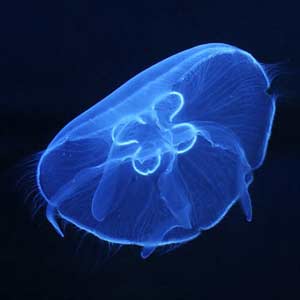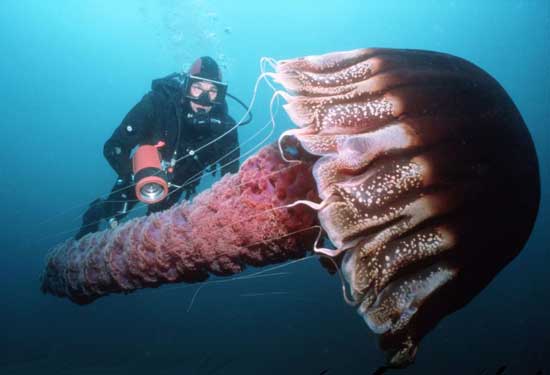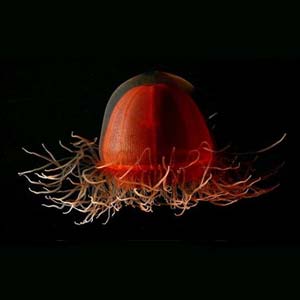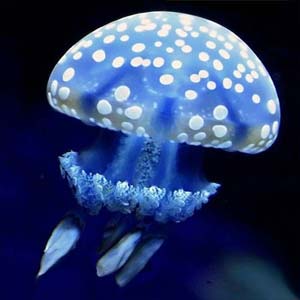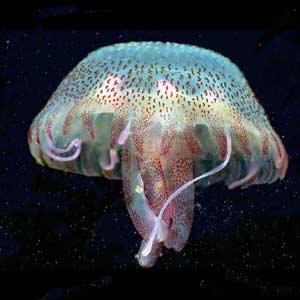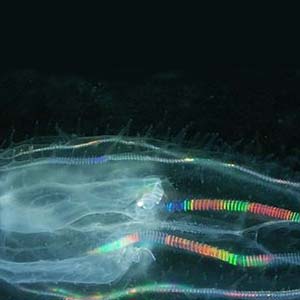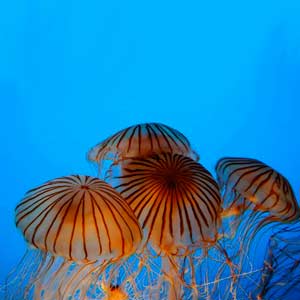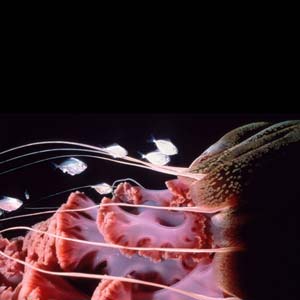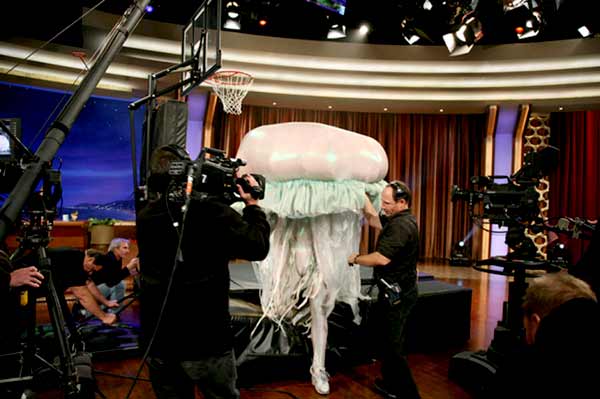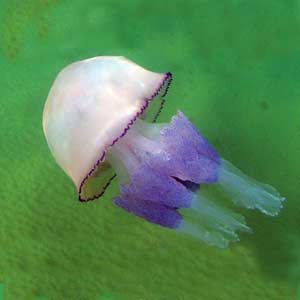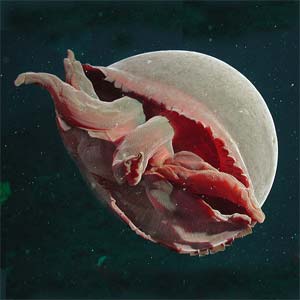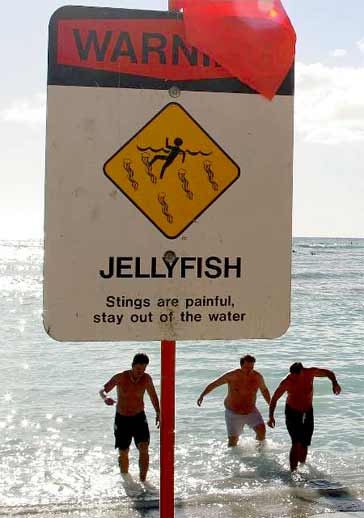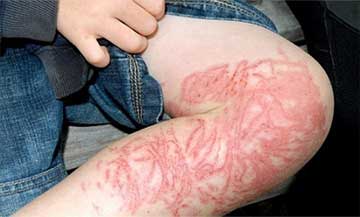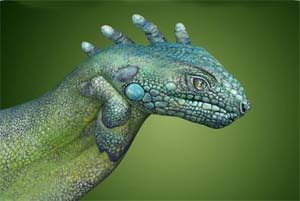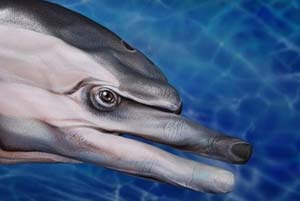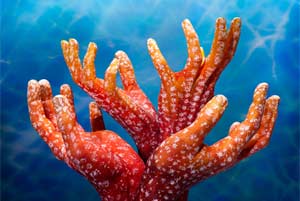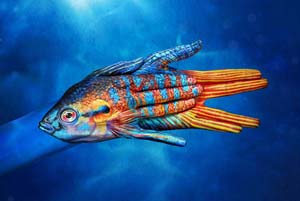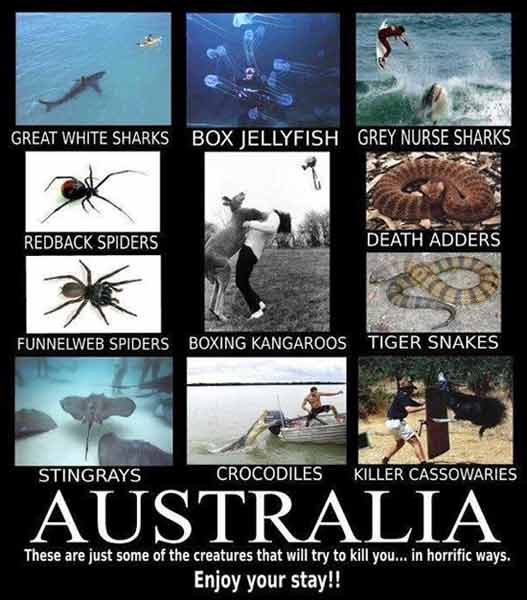A diver gazes at a giant jellyfish, identified as Nomura (Sometimes identified as Stomolophus nomurai and sometimes as Nemopilema nomurai) more than a metre across,
drifting off Echizen, Fukui prefecture along Japan’s central coast. This type of jellyfish can weigh as much as 150 kilograms (sometimes reports say 220 kilograms).
Jellyfish or jellies belong to the phylum Cnidaria (meaning “stinging nettle”). They’re typified as free-swimming marine animals that consist of a non-living jelly-like substance called mesoglea sandwiched between two layers of skin that are mostly only one cell thick. They have two basic body forms: swimming medusa and immobile polyp. Medusae have gelatinous umbrella-shaped “heads” called bells and they trail tentacles. The stinging tentacles growing from their heads look a bit like the mythological snakes sprouting from the head of the Greek goddess Medusa, hence the name. Jellyfish bells pulsate for locomotion and they use their stinging tentacles to capture prey. Many types exhibit bioluminescence (they glow in certain light). There are 4 classes: Hydrozoa (includes hydra, Portuguese Man o’ War, and Benjamin Button and Flower Hat jellyfish), Scyphozoa (Crown, Cannonball, Sea Nettle, Nomura, and Lion’s Mane jellyfish), Cubozoa (includes the deadly Box jellies), and Anthozoa (includes sea anemones, corals, and sea pens). The anthozoa don’t have a medusa stage in their development but instead release sperm and eggs that form larvae, which attach to things fixed and firm; they eat and grow in that very spot from then on.
Jellyfish are found in every ocean, from the surface to the deep sea. A few inhabit fresh water. Large, often colourful, they’re commonly found in coastal zones worldwide—they’ve roamed the seas for at least 500 million years (possibly 700 million or even more, depending on your theory); they are possibly the oldest multi-organ animal.
As jellyfish are not vertebrates, let alone true fish, the word jellyfish is considered by many to be a misnomer. The term “jellies” has become more popular. A group of jellies is sometimes called a bloom or a swarm. Bloom is usually used for a large group that gathers in a small area, but may refer to seasonal increases or numbers beyond what was expected. They’re “bloomy” by nature, being produced usually in the spring when sunshine and plankton increase. They appear rather suddenly, often in large numbers—even when an ecosystem is in balance. Swarm usually implies some kind of active ability to stay together, which a few species (such as the Moon jelly) do seem to have. (Moon Jellies also luminesce.)
- The Flower Hat jelly (Olindas formosa) is a somewhat rare species found in coastal waters primarily off Brazil, Argentina, and southern Japan. It’s semi-benthic, meaning it spends some of its time near the seabed. Its tentacles coil and adhere to its edge when not in use. It grows to about 15 centimetres (6 inches) in diameter and eats small fish. Blooms can be so dense that they interfere with shrimp nets. Its sting is quite painful to humans.
- Warmer, anoxic conditions due to a combination of pollutants and higher than normal temperatures appear to be among the reasons for a rapid increase in the Nomura (Nemopilema nomurai or Stomolophus nomurai) jellies’ population. Overfishing of predators is also a factor. Estimates of up to 20 billion Nomura were thought to be in the Yellow Sea by 2009 (almost 3 times the total human population). Scientists at first promoted the use of metal nets to cut through these jellyfish to kill them. Unfortunately death causes jellies to release their eggs (which number in the billions) and each piece of tentacle still releases toxins when washed ashore, so this tactic was soon halted. Nomura had bloomed only every few decades in the past (polyps on the sea floor reacted only infrequently to whatever subtle changes in the environment triggers their free-swimming phase); but starting in 2002, they’ve bloomed almost every year. This may be economically significant but is it ecologically significant? More information is needed.
- The Cannonball jelly (Stomolophus meleagris) is sometimes known as the Cabbage Head jelly; it lives along the coast of the US Eastern Seaboard and extends as far south as the Brazilian coast. It’s apparently named for its shape. One interesting little twist is how it sexually reproduces. It can reproduce asexually but when it doesn’t, it shoots sperm from its mouth to be caught in the mouth of a receiving jellyfish. (Asked? Demanded? Who knows?) Although Cannonballs don’t commonly sting humans, they secrete a mucous from their toxin-producing nematocysts, which can cause cardiac problems (irregular heart rhythms). The toxin is also harmful to the eyes and it can hang around a while in calm water, just waiting to snare a passer-by. Along the coast of the southern US state of Georgia, these jellies are a valuable export. They end up on dining tables across Asia. They’re dried, preserved, and packaged before being sold to a seafood distributor that ships them to Japan, China, and Thailand. Jellyballs (as they’re known locally) are Georgia’s 3rd largest commercial fishery after shrimp and crabs.
- Moon Jellies (Aurelia aurita) are also known as Common jellyfish or Saucer jellies. They’re usually seen in large numbers. The Moon jelly’s bell is between 5 and 40 centimetres across; it often has stripes or patterns of spots and can be either opaque or transparent. The easiest way to recognise a Moon is by the 4 horseshoe-shaped gonads present on their bells. Their main food is zooplankton. They also eat molluscs, rotifers, nematodes, diatoms, larval fish, crustaceans, and protozoa. Their sting is unpleasant, but not fatal.
- Tropical-dwelling Box jellies (Class Cubozoa including Chironex fleckeri and other rather poisonous varieties) have a cube-shaped body and 4 types of special-purpose eyes: the most primitive set detects only light levels (so they know which way is up), but another set is more sophisticated, having retinas, corneas, and lenses that allow them to see the colour and size of objects. These active swimmers rapidly make 180° turns and deftly dart between objects. They’re often called Sea Wasps; their stings are extremely painful and can be fatal (Chironex is the largest and most deadly of the Box-type). A Box jelly has the closest thing any known jellyfish has to a brain, displaying complex, probably visually-guided behaviours including obstacle avoidance and fast directional swimming. Tests show Boxes have a (limited) memory and they evidence an ability to learn from experience. Sea turtles are apparently unaffected by their stings and eat Box jellyfish (one of their very few predators). Wearing pantyhose or full body Lycra suits during diving (both women and men should do this under their scuba-diving suit) is said to be an effective protection against Box jellyfish stings because the tentacles aren’t triggered by touch, but by chemicals found on human skin. Largely ignored by science for decades—outside the Far East they’re not commonly eaten nor do they make popular pets and so are of little commercial interest—they’ve been in the news lately for all the wrong reasons. Unexplained blooms of these enigmatic invertebrates now cause trouble in Hawaii, Spain, and Northern Ireland. Box jelly venom is one of the most deadly in the animal kingdom, having caused at least 5,568 recorded deaths since 1954. (And a great many deaths go unrecognised: they’re instead classed as drowning due to cramp or too much alcohol or heart attack or unknown cause.)
- Proteins in many jellyfish appear to glow when exposed to ultraviolet light. This Moon jelly is one. In luminescent animals, chemical compounds mix together to produce this glow. Most of the world’s bioluminescence exists in the ocean, not on land. Bioluminescent life forms live throughout the ocean’s depths, but most exist in one particular zone called the twilight zone. This zone is also known as the disphotic (poorly lit) zone. It’s deeper than the euphotic (sunlit) zone, but shallower than the aphotic (midnight) zone. Its exact depth depends on a number of factors, including the composition of the water and the features of the ocean floor. But in general the twilight zone extends from about 660 feet (201 metres) to about 3,300 feet (1,006 metres). Only a small amount of light from the sun reaches this depth. Seawater absorbs red, orange, and yellow sunlight and scatters violet light, so the light that reaches the twilight zone is bluish-green in colour. This is partly because blue-green light has a short wavelength, giving it more energy with which to penetrate water. Luminophores, isolated from jellyfish, are used for biochemical analysis. Medusa genes for luminescence have been transplanted to many other animals, allowing biologists to observe previously inaccessible processes in vivo.
The Basics
Jellies’ archetypal life cycle is an alternation of life-history stages between a small, cryptic, benthic polyp and a conspicuous, free-swimming, open-water medusa. The polyp produces medusae by asexual budding, whereas the medusa reproduces sexually. This alternation of stages means jellies can be present (as polyps) even when they’re not obvious to the casual observer.
The Cnidaria are found in all pelagic environments (pelagic means living in the water column as opposed to being benthic), but attain greatest abundances near the coast. Approximately 200 species have been described. Jellies of the class Cubozoa are cuboidal (surprise!); most are fist-sized or smaller, although a few are much larger, such as that deadly Australian Sea Wasp Chironex, which has a polyp stage in its life cycle, but unusually, its polyp develops into only a single medusa (without budding). There are 20 species, restricted to temperate and tropical shelf waters.
In biology, a medusa (plural: medusae) has its mouth located on its lower surface (the mouth may be partially closed by a membrane as this organ handles both inputs and outputs—but never mind). Digestion takes place in the gastrovascular (digestive and circulatory) cavity and the canals that radiate outward from it. Along the edge of the “head” are located the sensory organs. The organ systems of most jellyfish aren’t overly specialised. Jellies don’t need a respiratory system since oxygen diffuses through their thin skins. Most have only limited control over movement, but they can navigate via contraction-pulsations (pulsating jellyfish stir up oceans with as much vigour as tides and winds, making them major players in ocean mixing); some actively mostly swim, others passively drift. Their bodies contain between 95 and 98% water bound into a gelatinous substance surrounded by a protective skin: the outer skin is the epidermis, the inner is the gastrodermis.
Jellies employ a loose network of nerves in their epidermis called a “nerve net”. Although traditionally not called a central nervous system, its concentration of nerves and associated ganglion-like structures would be considered to constitute one in most other species. To attribute much awareness to such a simple creature is difficult, is it not? But the jelly does detect various stimuli—including another creature’s touch.
Some species of jellies explicitly adapt to tidal flux, riding the current at ebb tide until they hit a gravel bar beside which they descend below the currents, remaining there in still water until the tide rises; they then ascend and allow themselves to be swept back into the bay. Jellies monitor salinity so they can avoid fresh water (they dive downward until they find sufficient salt). Some jellies have only those light-sensitive organs that tell them which way is up. (Submarines and bathyspheres must confuse them no end.)
Hermaphroditism. Cloning. External fertilisation. Self-fertilisation. Courtship and copulation. Fission. Fusion. Cannibalism. You name it, jellyfish [are] doing it.
Lisa-Ann Gershwin, Stung! On Jellyfish and the Future of the Oceans
This giant jelly was discovered in the Pacific Ocean off the coast of California.
The creature (Chrysaora melanaster) grows to twice the size of a fully-grown man and has nasty stings in its tentacles.
Are They Cockroaches of the Sea?
Huge annual jelly blooms are being found across the Mediterranean, in the Black Sea, the Gulf of Mexico, the Yellow Sea and the Japan Sea. Is this the beginning of a state change in marine diversity? Will the seas fill with slime? Some scientists think this a real possibility . But some scientists aren’t so sure. One jellyfish-like creature involved in the outsized bloom, Mnemiopsis, lays eggs before it is 2 weeks old, without needing a mate (not enough time to get to know each other anyway); it eats over 10 times its own body weight in food and doubles in size each day. Juveniles of two of these species live as parasites on salps on which adults of their species feed, so they apparently eat their own kids for dessert. Many jellyfish are extremely difficult to kill—when faced with death, some, such as the Benjamin Button jelly (Turritopsis), can 'de-grow'—they return to the polyp stage for a bit before budding into genetically identical medusae. Plastic bags and drift lines disturb jellies’ few natural predators, such as sea turtles. Jellyfish also use hard litter, including industrial waste, to form their expansive nurseries.
Last year, nuclear power plants in Scotland, Japan, Israel, and Florida, and a desalination plant in Israel were forced to shut down because jellies clogged water inlets. The Irish salmon industry was wiped out in 2007 after a plague of billions of Mauve Stingers (Pelagia noctiluca) attacked fish cages. The bloom covered a 10-square-mile area 35 feet deep–that’s 26 square kilometres covered 11 metres deep and all apparently frightened by—or perhaps attracted to—the farmed salmon. The jellies carpeted the cages to such an extent that what fish weren’t stung to death were asphyxiated. Two years later, a fish farm in Tunisia lost a year’s production of sea bream and sea bass the same way.
In waters off Japan, refrigerator-sized gelatinous monsters called Nomura, weighing 220 kilograms (485 pounds) and measuring 2 metres (6.5 feet) in diameter, have swarmed the Japan Sea virtually annually for the past decade, clogging fishing nets, overturning trawlers, devastating coastal livelihoods. It’s hard to calculate financial damage to fishermen, but the Japanese government last year counted about 50,000 incidents of jellyfish trouble. (Fish poisoned by jellyfish tentacles die with their mouths agape. That mars their appearance and reduces their value by as much as 20%. When their mouths are wide open, it means they’ve died going, 'I’m in pain! I’m in pain!’) The losses to the Japanese fisheries industry is said to amount to billions of yen. The first infestation occurred following the collapse of what had been an enormous Japanese sardine population.
Some marine ecologists warn of worse to come. A few researchers fear a tipping point in which jellies rule the seas, much as they did hundreds of millions of years ago. If we don’t act to curb current blooms, they say, we’ll experience runaway populations that may cause open oceanic ecosystems to flip from dominated by fish biodiversity to being dominated by jellies.
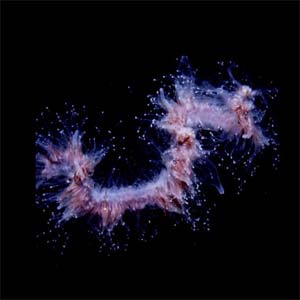
Long Stringy Stingy Thingy
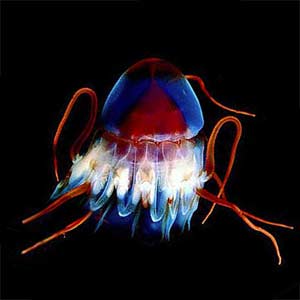
Benjamin Button Jellyfish
- Deep-Red jellyfish (Crossota norvegica) is a deep water polar hydromedusae. It has 10-14 radial canals, as opposed to 8 radial canals common to other species of Crossota. It possesses about 275 tentacles; its stomach is bottle-shaped, with irregular longitudinal ridges and invaginations. Its gonads are on radial canals near base of its stomach. This specimen was found in the Arctic just off the sea floor in the Beaufort Sea north of Point Barrow, Alaska during the Hidden Ocean Arctic 2005 expedition with the US National Oceanic and Atmospheric Administration, Office of Ocean Exploration.
- The String jellyfish (Apolemia uvaria) also known as the Barbed Wire jellyfish, and Long Stringy Stingy Thingy is a member of the class Hydrozoa. String jellyfish are colonial animals which may reach 3 metres in total length and have a diameter of 2-5 centimetres. The colony is formed of a central string bearing groups of pink and white tentacles which clump together or extend. The whole colony has a gas float at the front and a set of swimming bells. It is pelagic and found in oceans worldwide in mid-water. These ocean predators act like drift nets, spreading their tentacles to catch plankton. Tentacles give a painful sting and are best avoided. This specimen was found 10 metres below the surface in False Bay, Cape Town, South Africa.
- Immortal jellyfish (Turritopsis dohrnii) are among the most unique animals in the animal kingdom. They are able to revert back to a juvenile form after becoming sexually mature and mating—the only animal known to accomplish this. They originated in the Caribbean but have now spread throughout the world. They are found in temperate to tropical regions, believed to have spread via ballast water. Size is about 5 millimetres. The young have only 8 tentacles, while adults have 80-90. This jelly and its ability to reverse ageing is now a focus of research by geneticists. After sexually reproducing, it reabsorbs all external parts and becomes cyst-like. The cyst attaches to a hard surface and grows into a stalk-shaped polyp colony. These polyps begin a new cycle, where they eventually become mature jellyfish—all genetically identical.
It’s Actually More Complicated than That
Although dense jelly aggregations are a natural feature of healthy pelagic ecosystems, a picture emerges of more severe and more frequent outbreaks occurring in many areas. Unfortunately, jellies are fragile and difficult to sample, but available information suggests aggregations are increasing. More frequent jelly outbreaks have been reported worldwide. These have had deleterious consequences, including losses in tourist revenue through beach closures and even deaths of bathers; power outages following the blockage of cooling intakes at coastal power plants; the blockage of alluvial sediment suction in diamond mining operations; burst fishing nets; catches contaminated; interference with acoustic fish assessments; deaths of farmed fish; reduction in abundance of commercial fish catches; and increased parasites (this one’s a maybe) on local fish populations. The causes of these increases (assuming it’s not just part of a less-frequent, but nevertheless normal, cycle) appear to be overfishing, eutrophication (high nutrient levels in coastal waters that bring increased algae, increased turbidity, and decreased oxygen), climate change, species translocations, and habitat modification. Jellies replace common productive food webs dominated by higher organisms such as fish. They are, in other words, an economic burden. And a nuisance. And many of them are downright dangerous.
Scientists across the Mediterranean say a surge in the number of jellyfish this year threatens not just the biodiversity of one of the world’s most overfished seas but also the health of tens of thousands of summer tourists. There are now beaches on islands that receive hundreds of thousands of tourists a year, where people can only swim for a week in the summer. The Institute of Marine Sciences in Barcelona has detected a surge this spring in one of the most poisonous species, the Mauve Stinger, along the coasts of Catalonia and Valencia. Other badly hit coastlines include Sardinia, Sicily, Malta and the eastern Mediterranean beaches of Israel and Lebanon. At least 150,000 people are treated for jellyfish stings around the Mediterranean each summer.
The Chinese, on the other hand, have been eating jellies for more than 5,000 years. They export US$20 million worth each year to other Asian countries. Chinese immigrants in Sicily have also begun to harvest them. At least one species of Mediterranean jellyfish – the fried egg jellyfish (Cotylorhiza tuberculata) is a potential source of raw material for cancer treatments and antioxidants.
In the past summer, Britain’s Marine Conservation Society (MCS) says several species of jellies including Lion’s Mane are being reported in rapidly growing numbers around the UK. Yet the UK Foreign Office updated its travel advice for Greece in the wake of large jellyfish blooms there. (They say that there are different factors and different species in the UK.) Blue and Compass jellyfish are very common in the southwest of England. Moons are found all around UK coastal waters in large numbers and a growing number of Lion’s Mane around north Wales and the northwest of England. Since Lion’s Mane feed on Moon jellies, big blooms of Moon are often followed by big blooms of Lion’s Mane (this is one of the largest species with a sting powerful enough that scientists advise people not to approach them).
It’s almost summer in Australia. Scientists recently discovered a mysterious new species of jellyfish in New South Wales. In Auckland, New Zealand swimmers have encountered a profusion of tiny stinging jellyfish the size of pepper grains.
Jellyfish are 97% water or something, so how much are they doing? Just give them another 3% and make them water. It’s more useful.
― Karl Pilkington
- Spotted or Lagoon jellyfish (Mastigias papua) live in quiet bays, harbours and lagoons around the South Pacific. They’re recognised by their white spots. They have several small mouths and eat zooplankton. They’re harmless to humans and grow to be about 15 centimetres (6 inches) in diameter, living slightly longer than a year.
- There has been a surge in numbers of one of the most toxic species of jellyfish, the so-called Mauve Stinger (Pelagia noctiluca).
- The Mediterranean jelly (Cotylorhiza tuberculata) is one of the more beautiful varieties. Located in the Mediterranean, Aegean and the Adriatic Seas, it is pelagic, staying in the coastal bay open sea. Its diameter is about 40 centimetres. It has a sting, but is relatively harmless to humans. It’s often found in aquaria in Japan—its slow regular pulsing is considered by some to relieve stress.
- Comb jellies aren’t true jellyfish (as they lack stinging cells); instead, they belong to the phylum Ctenophora (meaning “comb”). This comb jelly is a new species found recently off the coast of Tasmania. It grows to about 5 inches (13 centimetres) long.
- The Japanese Sea Nettle (Chrysaora fuscescens) has a painful sting but it’s not considered harmful.
- Juvenile fish shelter among the tentacles of a Giant Pelagic jellyfish (Chrysaora achlyos), Channel Islands, California, East Pacific Ocean.
Cousins, You Say?
Basically, jellyfish need to eat, and jellyfish are eaten by things as well, so they’re part of a healthy ecosystem. While there’s no doubt that jellies are showing up more frequently in some places around the world, it’s not absolutely clear that blooms are more intense than years prior because scientists can’t determine population sizes. Undoubtedly blooms have increased in localised areas, but on a global scale, we don’t know enough about populations, biology, or distribution, to make a firm judgement. Is evidence of population increases significant? The annual removal globally of between 100 and 120 million tonnes of marine life (fish, invertebrates, discarded by-catch and illegal and unreported species) over the past two decades could encourage jelly outbreaks. Long-lasting fishery-related stock collapses appear to be occurring with increasing frequency worldwide. Many of the fish being “removed” compete for the same prey as jellies and more than 100 species of fish (as well as turtles) being removed are also jellyfish predators (some munching on polyps, others snacking on small jellies). It would seem logical that jellyfish numbers would increase.
In the productive northern Benguela upwelling system off the coast of Namibia, intense fishing has decimated sardine stocks. This once-productive fisheries system is now dominated by jellies. Perhaps the collapse of the sardine stocks lowers predation pressure on jellies while simultaneously increasing their available food. Intensive trawling of the seafloor might contribute to blooms because trawling removes large numbers of potential competitors and predators, while nearby rocky outcrops (which trawlers avoid) give jelly polyps safe refuge. But the biggest problem in identifying changes in jellyfish populations is that they’re naturally quite variable from year to year. Scientists have little information about where jellyfish polyps are that bud off to form the familiar medusae. What are the conditions needed for this life-stage change? Jellyfish blooms are nothing new; sudden proliferations of medusae are recorded in the fossil record more than 500 million years ago. Just how different are they today?
In 2012, scientists tallied jellyfish abundance annually after 1950 across 45 marine ecosystems including coastal waters and seas. About 62% of the surveyed large marine ecosystems showed increased jellyfish populations. The study showed that non-indigenous jellyfish invasions across 4 marine ecosystems—the Gulf of Mexico, Southeast US Continental Shelf, Caribbean Sea, and Baltic Sea—contributed to these increases. But what does it mean?
We can no longer accept that cnidarians are an evolutionary relic from the early days of animal evolution. They are in fact highly evolved to take advantage of their habitat and the higher animals within it, as their ability to kill all kinds of vertebrates (including humans) demonstrates. Soft-bodied animals don’t leave fossils easily, and their exact phylogeny is always controversial. The truth about jellyfish is that they mess up our established ideas about evolution, and show us how much we have left to learn. According to their morphology, they’re simple animals. Like their relatives the sea anemone and the coral, jellyfish look like no-frills fauna. They have no heads, no backs or fronts, no left or right sides, no legs or fins, and no hearts. A jellyfish’s gut is a blind pouch rather than a tube so its mouth also serves as its anus. (How advanced is that?) Instead of a brain, it has a diffuse net of nerves—and with no front end, it functions well from any angle. It lacks the central layer of embryonic tissue found in higher animals that develops into muscles, heart and specialised organs (but water provides it these support systems instead). It has at least rudimentary eyes. In the traditional evolutionary tree, these features place it neatly between sponges and bilaterans (creatures with a front and back, like us). When animals become bilateral, they develop specific organs for different parts of the body. (It is this which gave rise to the incredible increase in diversity known as the ‘Cambrian explosion’.)
But new research has made scientists realise they’ve underestimated jellyfish. The first animals were probably sponge-like, little more than clumps of cooperative cells. Cnidarians seemed to represent a higher stage, having acquired traits like simple tissues and nerves. The fossil records of animals seems to back up that hypothesis. But it turns out that jellyfish are more complex than previously thought. Beneath their seemingly simple exterior lies a remarkably sophisticated collection of genes, including many that give rise to humans’ complex anatomy. They do in fact possess genes that program for a front-to-back axis, they appear to simply not utilise them. Either that, or the genes are being used to specialise their brains in some incredibly subtle way. At the molecular level, they have a lot of body regions that aren’t recognisable to us. This may mean that cnidarians are in fact descended from more complex, bilateral animals, and secondarily adopted their simpler shape. One Boston University biologist expects that the cnidarian neutral net is divided into specialised regions—much like the human brain.
A common ancestor may once have plugged the link between sponges and bilaterans (there are ideas about what that animal may have been); cnidarians continued to evolve until becoming the jellyfish we know today. Once the seas filled with animals, cnidarians took on their current form. The earliest ones anchored themselves to the sea floor and grew upward as sea anemones and corals do today. In the process, they abandoned the bilaterian body plan of their ancestors. It was also at this time that they evolved their distinctive weaponry: a cell containing a miniature harpoon called a nematocyte for paralysing prey with toxins. As new lineages of animals moved even higher into the water column, cnidarians evolved to hunt them as well. Jellyfish are the product of this final stage of evolution—they are nomadic warriors.
Why Is This Happening?
Coastal eutrophication encourages phytoplankton blooms that can lead to jellyfish outbreaks. Excessive nutrients alter pelagic communities in many ways in part because they’re often rich in nitrogen and phosphorus but poor in silica. Non-siliceous phytoplankton, such as flagellates (including the harmful red-tide species), proliferate and replace diatoms such that the food web now supports fewer fish, marine mammals, turtles and seabirds and becomes instead an environment more favourable for jellies. Jellies feed on a wide range of prey, including flagellates; they positively flourish around aquaculture, where fish food and fish waste produce eutrophication; additionally, pens and structures provide polyp habitats. Large phytoplankton blooms that result can sink to the seafloor, where their bacterial degradation causes localised hypoxia. Polyps and medusae have a greater tolerance than fish to low-oxygen conditions—so jellyfish survive while other species may not. During the summer of 2007 in the Gulf of Mexico, nutrient-rich outflows from the Mississippi River resulted in large phytoplankton blooms and 25,000 kilometres of oxygen-depleted waters. These “dead zones” favour jellies over commercially-valuable fish and shellfish. With the number of dead zones worldwide doubling each decade since the 1960s, increasing coastal habitats are more suitable for jellies than fish.
Ocean warming might also favour some jellies. Warming of the surface enhances water column stratification, leading to nutrient-poor surface waters. Flagellates, with an ability to migrate vertically into nutrient-rich deeper waters, outcompete diatoms. Warming will almost certainly expand distribution of the most venomous tropical jelly species toward subtropical and temperate latitudes. For example, the northeast Australian coast is home to two types of Box jellies: the Sea Wasp and the species complex known as Irukandji. Stings from both can be fatal and force beach closures. The warm southward-flowing East Australia Current has strengthened over the past 60 years, caused by altered circulation patterns in response to climate variations. There’s growing concern that Box jellies might expand southward toward more populated areas, causing severe repercussions for the tourist industry. Another aspect that influences jellies is ocean acidification, a result of increased atmospheric CO² concentrations.
The human-assisted movement of species to new marine areas is most commonly caused by the exchange of ballast water between regions and the transport of fouling biota (for example polyps) on ship hulls. Some jellies are robust to ballast water exchange, and have often increased in abundance once translocated to new areas where the dominant plankton-eating fish in the system have been removed. For example, following the anchovy stock collapse in the Black Sea (apparently due to overfishing), the abundance of a type of jelly introduced some years earlier abruptly exploded to dominate the pelagic ecosystem. These same invasive jellies made their way to the Caspian Sea to become a factor in the commercial extinction of the beluga caviar industry and the reduction of sturgeon and anchovy stocks; they’ve now invaded both the Baltic and North Seas. Elsewhere, jelly blooms have appeared in areas previously free of invading jelly species. The Spotted jelly from the Pacific Ocean is now a nuisance in the Gulf of Mexico where aerial surveys estimate a total of 5,000,000 jellies over 150 kilometres—equivalent to 40,000 tonnes. They clog shrimp nets, costing shrimpers millions of dollars.
- Barrel jellies (Rhizostoma pulmo) are also called Dustbin-Lid jellies or Frilly-Mouthed jellies. They’re found in the northeast Atlantic, the Adriatic Sea, the Mediterranean Sea, and the southern Atlantic off the western South African coast and into False Bay. They’re quite common in the Irish Sea, but migrate south as waters warm. They typically reach 40 centimetres (16 inches) in diameter but have been reported to reach 90 centimetres (35 inches). They’re a favourite food of the leatherback turtle.
- Anyone unfamiliar with the biology of the venomous Portuguese Man o’ War (Physalia physalis), would likely mistake it for a jellyfish. Not only is it not a jellyfish, it’s not even an “it,” but a “they,” a siphonophore made up of a colony of organisms working together. The Man o’ War comprises 4 separate polyps, getting its name from the uppermost one, a gas-filled bladder (pneumatophore) which sits above the water and somewhat resembles an old warship at full sail. Man o’ Wars are also known as Bluebottles for the purple-blue colour of their pneumatophores. The tentacles are the second organism—long, thin tendrils extend up to 165 feet (50 metres) in length below the surface (although 30 feet—10 metres—is more the average). They’re covered in venom-filled nematocysts. For humans, a sting is excruciatingly painful but rarely deadly. But beware—even dead carcasses washed up on shore still sting. Muscles in the tentacles draw prey up to the polyp containing the gastrozooids or digestive organisms. Finally, a fourth polyp contains reproductive organs. Man o’ Wars are sometimes found in groups of 1,000 or more, all floating in warm waters throughout the world’s oceans. They have no independent means of propulsion but drift on currents or catch the wind with their pneumatophore. To avoid surface threats, they deflate their air bags and briefly submerge.
- Tiburonia (Tiburonia granrojo) is a jellyfish of the family Ulmaridae discovered in 2003, and the only member of its genus yet identified. Tiburonia are one of the largest sea jellies and unusual in a number of ways. They live at ocean depths of 600 to 1,500 metres (2,000 to 4,900 feet) and are found across the Pacific Ocean, in the Sea of Cortez, in Monterey Bay, and off the coasts of Hawaii and Japan. They can grow up to 75 centimetres (30 inches) in diameter and have thick fleshy oral arms in place of the long tentacles found in most jellies. The entire jellyfish is deep red in colour. To date, only 23 have been found and only one—a small specimen under 15 centimetres (6 inches)—has been retrieved for further study.
Where to Now?
Jellies have a suite of successful attributes that enable them to survive: a broad diet, fast growth, the ability to shrink when starved, to fragment and regenerate, and to tolerate hypoxia. Ecosystems that switch to being dominated by jellyfish might never return to a pre-jellyfish state without intervention. One response is to harvest more jellyfish for human consumption. Several species are edible; others could be made so with improved processing. What’s needed is a combination of coping strategies and longer-term preventative responses. More fundamental research on jellyfish ecology, their complex life cycles, and their ecosystem roles is needed. We know neither the appearance nor location of the polyp stage for most species. Our knowledge of jellyfish diet is limited to a relatively small number of species. Information on jellyfish predators is improving, but gathering knowledge on basic jellyfish ecology is hampered by the scarcity of scientists with an active research interest, a direct consequence of the meagre funding allocated to this area. Despite the challenges of rearing jellyfish in the laboratory, knowledge of the impact of different temperatures on physiological processes of medusae and polyps is crucial. There’s even a shortage of basic information on growth efficiencies. Few marine ecosystem models currently include jellyfish; those that do rarely capture their complex life history and ecology needed for simulating possible alternate fish-jellyfish stable states. Lastly, a research area that has potential for considerable human benefit is investigation of the efficacy of many traditional medicinal uses of jellyfish. Jellyfish have been used to alleviate, cure, or improve an array of ailments, including arthritis, bronchitis, burns, fatigue, gout, hypertension, menstruation pain and ulcers. Recent studies confirm that jellyfish collagen suppresses arthritis in laboratory rats and stimulates autoimmune and inflammatory responses in humans. By studying jellyfish corpses, Japanese researchers find that jellyfish are rich in proteins known as mucins, large, sugar-coated proteins that protectively line our own airways and digestive tracts. The Japanese, saddled as they are with annual Nomura blooms, want to exploit these proteins’ tendency to form gel-like materials, a property which can be exploited in the food industry via use as an emulsifier. It may also prove vital in the cosmetics industry as a moisturiser. Japan is hoping to turn the hordes of slimy jellyfish littering their coastline into a national resource.
The potential replacement of fisheries by jellyfish in many regions is a concern in a world with an expanding population in developing countries that are dependent upon protein from the sea. But more than 20 scientists have now compiled over half a million reports dating back to 1790, and found no evidence for a notable global increase in jellyfish blooms. While there are some places experiencing a pronounced increase in jellyfish blooms (for example “they went berserk in Japan”), the data don’t support a huge global increase. Unfortunately, monitoring blooms can’t be done by satellite because jellies are transparent and have low biomass, often occupying waters below the optical satellite penetration depth and even finding polyps and larvae in sea grass is tricky. So, despite efforts, no one can say for sure if blooms are increasing.
Dealing with blooms where they do turn up is tricky. In Spain, special jelly patrols were dispatched to fish up huge nets full to bury in landfills. But we don’t know what environmental effects destroying blooms may have. Jellyfish are an important food source for apex predators, and if we tinker with the natural bloom system, there could be unexpected ripple-down effects. Sustainably exploiting their abundance may be best strategy. They’re popular attractions in aquaria and can be boiled and added to salads (the smaller varieties are said to be more tender and tasty). Trying to win converts, the fisheries ministry has drawn up a manual with tips on cooking with giant jellyfish. Menus include jellyfish-flavoured biscuits, jellyfish soaked in rum, and a dessert of jellyfish chunks in coconut milk. One coastal firm has for the past several years produced 2-3 thousand cartons of vanilla-and-jellyfish ice cream. Jellyfish is soaked overnight in milk to reduce the smell, then diced. Jelly cubes are slightly chewy. “We think it’s important to use local ingredients,” says the firm’s director, “and this has now become a local ingredient.” Jellyfish are 80% protein and very low in fat (but have a high sodium content).
So… jellyfish and chips anyone? (Nutritional information here)
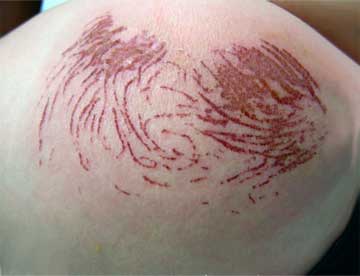
Stings on a 2-Year-Old’s Bottom
Sources:
http://science.howstuffworks.com/zoology/all-about-animals/bioluminescence.htm “How Bioluminescence Works” by by Tracy V Wilson.
http://plankton.jp/PBR/issue/vol03_suppl/03suppl_125.pdf ”Blooms of the giant jellyfish Nemopilema nomurai: a threat to the fisheries sustainability of the East Asian Marginal Seas” by Shin-ichi Uye, Plankton & Benthos Research, 4 February 2007.
http://en.wikipedia.org/wiki/Cubozoa Box Jellyfish from Wikipedia.
http://en.wikipedia.org/wiki/Cannonball_jellyfish Cannonball Jellyfish from Wikipedia.
http://en.wikipedia.org/wiki/Ctenophora Ctenophora from Wikipedia.
http://online.wsj.com/article/SB119612452419404666.html ”Invasion of Jellyfish Envelops Japan In Ocean of Slime” by Sebastian Moffett, The Wall Street Journal, 27 November 2007.
http://www.spiegel.de/international/europe/jellied-salmon-scientists-mystified-by-jellyfish-attacks-on-fish-farm-a-519666.html ”Jellied Salmon: Scientists Mystified by Jellyfish Attacks on Fish Farm” Spiegel Online International, 27 November 2007.
http://www.null-hypothesis.co.uk/science/strange-but-true/item/japan_jellyfish_swarms_economic_boom ”Jellies Gee Up Japan” by Ceri Harrop, Null Hypothesis: The Journal of Unlikely Science, 2007.
http://en.wikipedia.org/wiki/Jellyfish Jellyfish from Wikipedia.
http://www.ibtimes.com/jellyfish-blooming-seas-around-world-human-activities-global-warming-blame-439202 Jellyfish Blooming In Seas Around The World: Human Activities & Global Warming To Blame by Sanskrity Sinha, 19 April 2012.
http://www.swan.ac.uk/bs/turtle/reprints/Richardson et al 2009 TREE – The Jellyfish Joyride.pdf “The jellyfish joyride: causes, consequences and management responses to a more gelatinous future” by Anthony J Richardson, Andrew Bakun, Graeme C Hays, and Mark J Gibbons, Trends in Ecology and Evolution, Vol 24 No 6, 2009.
http://www.theguardian.com/environment/2013/jun/03/jellyfish-surge-mediterranean-environment-tourists ”Jellyfish surge in Mediterranean threatens environment—and tourists” by Giles Tremlett in Madrid, The Guardian, 3 June 2013.
http://www.livescience.com/8710-jellyfish-swarms-menacing-misunderstood.html ”Jellyfish Swarms: Menacing or Misunderstood?” by Wynne Parry, Live Science, 20 October 2010.
http://blogs.ei.columbia.edu/2011/02/26/giant-jellyfish-swarms-%E2%80%93-are-humans-the-cause/ “Giant Jellyfish Swarms — Are Humans the Cause?” by Renee Cho, State of the Planet, 26 February 2011.
http://www.bbc.com/future/story/20120405-blooming-jellyfish-problems/all “Jellyfish Blooms Creating Oceans of Slime“ by Gaia Vince, BBC Future, 5 April 2012.
http://www.dailymail.co.uk/news/article-2415225/Theyre-taking-bite-time-new-book-claims-jellyfish-destroy-oceans-overtake-boats-nuclear-plants.html “They’re taking over 'one bite at a time’: new book claims jellyfish destroy oceans and overtake boats, nuclear plants” by Daily Mail Reporter, 8 September 2013.
http://www.nytimes.com/2005/06/21/science/21jell.html?pagewanted=all ”Plain, Simple, Primitive? Not the Jellyfish” by Carl Zimmer, New York Times, 21 June 2005.
http://animals.nationalgeographic.com/animals/invertebrates/portuguese-man-of-war/ ”Portuguese Man O’ War,“ National Geographic.
http://www.dailymail.co.uk/news/article-2202204/Wonders-sea-Fascinating-pictures-mesmerising-collection-photos-oceans-depths.html ”Secrets of the sea: Fascinating pictures from mesmerising collection of photos from the ocean’s depths” by Emma Reynolds, Mail Online, 12 September 2012.
http://en.wikipedia.org/wiki/String_jellyfish String Jellyfish from Wikipedia.
http://www.nybooks.com/articles/archives/2013/sep/26/jellyfish-theyre-taking-over/?pagination=false “They’re Taking Over!“ by Tim Flannery, The New York Review of Books, 26 September 2013.
http://en.wikipedia.org/wiki/Tiburonia Tiburonia from Wikipedia.
http://www.environmentalgraffiti.com/ecology/terrifying-truth-jellyfish/12483 “The Terrifying Truth about Jellyfish” by Steampunk, Environmental Graffiti, 2009.
http://www.bbc.co.uk/news/science-environment-23492338 ”Warm weather sees boom in UK jellyfish blooms” by Matt McGrath, BBC News: Science & Environment, 30 July 2013.
Everything Else
by Guido Daniele
It’s hard to see how anyone could top these painted-hand examples. So can we retire this as an art form now?
1. A Higgs boson walks into a bar and asks everyone to take part in an act of penitence. “What are you doing?” asks the barman. “Giving mass.”
2. What did the proton say to the ever-grumpy electron? “Why do you have to be so negative all the time?”
3. Two atoms are walking down the street. One says to the other, “Hey! I think I lost an electron!” The other says, “Are you sure?” “Yes, I’m positive!”
4. Why are quantum physicists bad in bed? Because when they find the position, they can’t find the momentum, and when they have the momentum, they can’t find the position.
5. A Higgs boson walks into a bar. The bartender says, “What’s the matter?” The Higgs replies: “Exactly.”
A performative poet of Hibernia
Rhymed himself into a hernia.
He became quite adept
At this practice, except
For the occasional non-sequitur.
 Animals
Animals Animation
Animation Art of Playing Cards
Art of Playing Cards Drugs
Drugs Education
Education Environment
Environment Flying
Flying History
History Humour
Humour Immigration
Immigration Info/Tech
Info/Tech Intellectual/Entertaining
Intellectual/Entertaining Lifestyles
Lifestyles Men
Men Money/Politics/Law
Money/Politics/Law New Jersey
New Jersey Odds and Oddities
Odds and Oddities Older & Under
Older & Under Photography
Photography Prisons
Prisons Relationships
Relationships Science
Science Social/Cultural
Social/Cultural Terrorism
Terrorism Wellington
Wellington Working
Working Zero Return Investment
Zero Return Investment